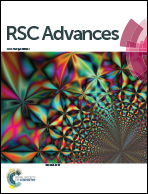Facile synthesis of vacancy-induced 2H-MoS2 nanosheets and defect investigation for supercapacitor application†
Abstract
In this paper, a 2D molybdenum disulfide (MoS2) nanosheet is prepared via a one-step hydrothermal method as electrode material for supercapacitors. Meanwhile, a series of MoS2−x nanostructures with sulfur vacancies have been successfully obtained in an Ar/H2 mixed atmosphere at different annealing temperatures. The prepared materials were characterized by XRD, HR-TEM, Raman and XPS to identify their morphology and crystal properties. MoS2−x assembled by interconnected nanosheets (MoS2−x-700) provides a maximum specific capacitance of 143.12 F g−1 at a current density of 1.0 A g−1 with 87.1% of initial capacitance reserved after 5000 cycles. The outstanding performance of the annealed MoS2−x nanosheets in sodium storage is mainly attributed to the synergistic effect of the unique interconnected structure and the abundant active vacancy generated by the sulfur vacancies. Atomic models of sulfur vacancy defects on the basal plane, Mo-edge and S-edge were established and the electronic properties of MoS2−x were further evaluated assisted by first principles theory. DFT calculation results show that sulfur vacancy defects can provide additional empty states near the Fermi level and induce unpaired electrons, thus increasing the carrier density and improving electrical conductivity. Our findings in this work provide experimental and theoretical evidence of improving the electrochemical performance of 2H-MoS2 nanosheets by annealing treatment.



 Please wait while we load your content...
Please wait while we load your content...